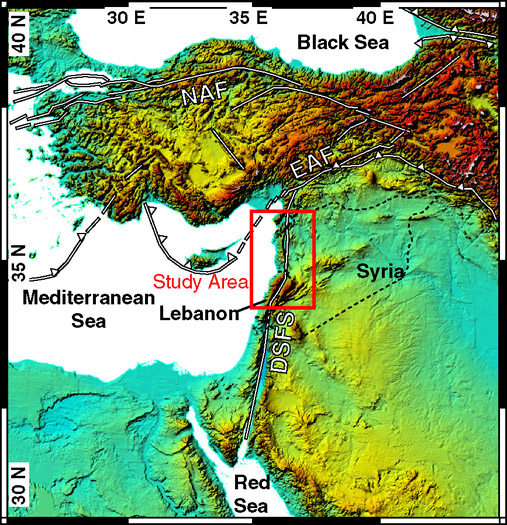Project Summary
 The
Dead Sea Fault System (DSFS) is one of the largest continental strike-slip
faults in the world. As the transform plate boundary between the
Arabian and African plates, the DSFS represents a key tectonic feature
in the eastern Mediterranean region. Despite its significance, the
understanding of the DSFS as an active, seismogenic structure is relatively
limited, particularly along the central and northern sections of the fault
in Syria and Lebanon. By studying active tectonic processes operating
at different time scales along the DSFS in Syria and Lebanon, this research
will address several important issues including:
The
Dead Sea Fault System (DSFS) is one of the largest continental strike-slip
faults in the world. As the transform plate boundary between the
Arabian and African plates, the DSFS represents a key tectonic feature
in the eastern Mediterranean region. Despite its significance, the
understanding of the DSFS as an active, seismogenic structure is relatively
limited, particularly along the central and northern sections of the fault
in Syria and Lebanon. By studying active tectonic processes operating
at different time scales along the DSFS in Syria and Lebanon, this research
will address several important issues including:
-
Whether or not the northern DSFS deformation fulling accounts for Arabia-Africa
plate motions and, hence, represents the present-day plate boundary.
-
How predictions of northward increasing slip rate and fault-normal convergence
(suggested by plate tectonic models) are reflected in the DSFS kinematics.
-
The role of earthquakes in plate boundary deformation along a major continental
transform (the DSFS) including fault segmentation and aseismic strain release.
-
The relationship of internal deformation of the adjacent Arabian plate
to kinematic variations along the DSFS, and the connection between the
DSFS and the Arabian-Eurasian collision.
In order to bridge the gap that typically exists between neotectonic
and geodetic/seismological assessments of strain, results of this neotectonic
and geodetic work are currently integrated with a lengthy, well documented
historical record of large earthquakes (approximately M > 6.5) over at
least the past 2,000 years. Such a lengthy historical record spanning
multiple earthquake cycles are generally unavailable along any other major
plate boundary and are unique to this region.
To address the issues outlined above, the following is being accomplished:
-
Regional mapping of the active branches of the DSFS using all available
remote sensing data (including aerial photos and a high-resolution elevation
models produced using InSAR) will determine geometric (and possible seismogenic)
segments.
-
Local neotectonic studies (including the Yammouneh and Ghab branches),
involving detailed mapping, surveying fault-related landforms, and paleoseismic
investigations, will delimit: (A) Long-term rates of fault
slip and kinematics (103 – 106 years), (B) earthquake histories and
recurrence over many earthquake cycles (Holocene to present), and (C)
preliminary constraints on past earthquake size. Historical earthquake
data will place further limits on earthquake size and recurrence during
the past 2,000 years
-
Tectonic geodesy (primarily GPS) in the far-field and near-field will determine:
(A) Short-term rates of fault slip and kinematics (several years),
and (B) assess possible aseismic slip vs. strain accumulation.
Integrating and modeling neotectonic, geodetic, and historical data
for the DSFS will provide new insight on the kinematics and dynamics of
the DSFS with broader implications for active strike-slip faults, in general.
Furthermore, the results of this study will have significance for regional
earthquake hazard in Syria and Lebanon, as well as neighboring countries,
where large, rapidly expanding populations heighten the need for accurate
earthquake hazard assessments.
This collaborative study builds upon past and ongoing joint research
involving Cornell, MIT, IPG Strasbourg, and Syrian and Lebanese institutions.
 Return
to Project Home
Return
to Project Home
Page last updated September 4, 2001.
 The
Dead Sea Fault System (DSFS) is one of the largest continental strike-slip
faults in the world. As the transform plate boundary between the
Arabian and African plates, the DSFS represents a key tectonic feature
in the eastern Mediterranean region. Despite its significance, the
understanding of the DSFS as an active, seismogenic structure is relatively
limited, particularly along the central and northern sections of the fault
in Syria and Lebanon. By studying active tectonic processes operating
at different time scales along the DSFS in Syria and Lebanon, this research
will address several important issues including:
The
Dead Sea Fault System (DSFS) is one of the largest continental strike-slip
faults in the world. As the transform plate boundary between the
Arabian and African plates, the DSFS represents a key tectonic feature
in the eastern Mediterranean region. Despite its significance, the
understanding of the DSFS as an active, seismogenic structure is relatively
limited, particularly along the central and northern sections of the fault
in Syria and Lebanon. By studying active tectonic processes operating
at different time scales along the DSFS in Syria and Lebanon, this research
will address several important issues including: